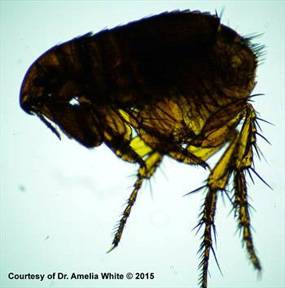Ctenocephalides felis

Ctenocephalides felis. Courtesy Dr. Amelia White
Although there are over 2000 flea species in the world, pet owners should be concerned with only one: Ctenocephalides felis, the cat flea. This is the flea that we find on our pets (cats, dogs, rabbits, and other species) in 99.9 percent of cases. In order to understand how to control the damage caused by this tiny little animal, learn all you can about it.
Fleas can cause serious health problems for you and your pet.
Fleas aren’t just a nuisance! Fleas can kill. Fleas suck blood and blood loss leads to anemia. A heavy flea burden is lethal, especially to smaller or younger animals. The cat flea has even been known to kill animals as large as dairy calves through heavy infestation.
Fleas can cause serious skin issues
Fleas can cause severe itching and also other problems such as skin infections and hair loss. Some animals can become allergic to fleas, and flea allergy dermatitis is the most common skin disease of dogs and cats.
Fleas can transmit infections and parasites
Fleas can carry and transmit a bacterium called Bartonella that can cause health issues in cats, dogs, and people. Fleas can carry a type of parasite, a tapeworm called Dipylidium caninum that can suck nutrients from the pet’s intestine and cause anal itching.
Common Myths
Even though fleas are the most common parasite in dogs and cats, there are many misconceptions about them. Myths that veterinarians hear about fleas almost every day are:
Myth: My pet cannot have fleas because he lives entirely indoors.
Fact: Fleas thrive particularly well in the well-regulated temperatures in the home.
Myth: My pet cannot have fleas because if there were any fleas they would be biting (insert name of a person in the family reportedly sensitive to flea bites). Since this person is not being bitten, there must not be any fleas.
Fact: The cat flea, Ctenocephalides felis, can suck the blood of a wide variety of animals. However, this flea definitely does not prefer human blood and won’t eat it unless absolutely necessary. Humans tend not to be bitten unless flea population numbers are high.
Myth: We do not have fleas because we only have hardwood floors.
Fact: Fleas love to develop in the cracks between the boards of hardwood floors.
Myth: My pet cannot have fleas because I would see them.
Fact: You cannot expect to see fleas because many animals will lick, groom, and chew after being bitten by a flea. This causes the flea to either jump off the pet or get swallowed.
The Flea Life Cycle
There are four life stages of the flea. For effective flea control, it is important to know how to break this life cycle in more than one place.
The flea life cycle consists of egg, larval, pupal, and adult stages. Eggs are laid in the hair coat and are designed to fall off your pet and into your home. Larvae hatch from the eggs and develop in a pet’s environment by feeding on adult flea feces (i.e. digested blood) that fall out of the hair coat of the pet. Larvae eventually spin cocoons, often within carpet fibers, for pupation. Pupae are resistant to freezing, drying, and insecticides, and can lie dormant for many months! New fleas develop from pupae and can begin feeding within hours of finding a dog or cat. The entire flea life cycle can be completed in as little as three weeks.
Flea Control Strategies
New Products
Today, veterinarians have some great flea control products in our arsenal. There are now many effective and safe new products to choose from.
Break the Flea Life Cycle
A two-step approach, targeting both the adult flea and the egg or larval flea forms, provides the most rapid control and the least resistance to flea control agents in future flea generations.
Year-round Flea Control
Fleas are also adaptive and the temperature controls how fast the flea completes its lifecycle. If you want to eradicate the flea population in a specific home, it is best to attack when numbers are low in the winter. Stopping flea control products in the winter may make it much harder to gain the upper hand in the spring and summer when the populations are rising.
Rotate Flea Products
Over time, only fleas resistant to an insecticide will survive. Periodically switching to another type of insecticide can be part of an effective flea control program to help reduce developing resistant fleas.
Sadly, fleas are here to stay one way or the other. Know as much about this pest as you do about the dogs and cats that it feeds upon. You cannot know too much when it comes to flea control!